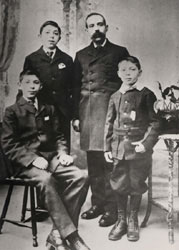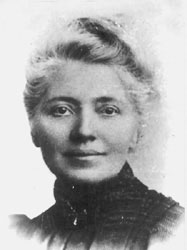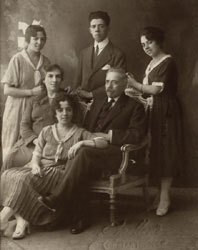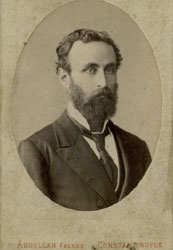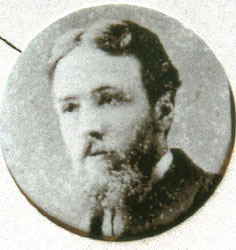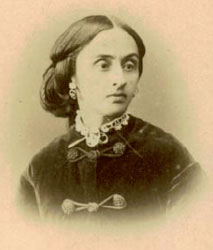My family connection
with the Levantine community of Smyrna and Constantinople dates from around
the 1830s to the turn of the century. My family history has connections
with the families of CALLUS, GRISCTI, SCEBERRAS, CALLEJA, POUHALSKI (aka
Pohalski, Puchalski) and VAN MILLINGEN.
HENRI CALLUS was my great grandfather. His sisters EMILIA, THERESE and JOSEPHINE never married and it’s thought they worked as teachers in Constantinople. They emigrated to Malta probably sometime in the 1920s at the time of the main exodus of Europeans from Turkey. Hortense also remained single but stayed in Constantinople/Istanbul at least until the 1930s. In the 1920s she was residing at her late parent’s home near the Galata Tower, but by the 1930s had moved to Stamboul (the old quarter of Istanbul on the opposite side of the Galata Bridge on the European side of the city). She may have moved to the UK or Malta later in the 30s.
Notes: 1- Fellow contributor Alex Baltazzi was able to source this image, an advert from 1914, details of which were published in the book ‘135 Yıllık Bir Hazine - Osmanlı Bankası Arşivinde Tarihten İzler [A treasure trove of 135 years - Traces of History within the archives of the Ottoman Bank] - Edhem Eldem - an Osmanlı Bankası Publication, 1997’, the name of the manager of the Pera branch turns out to be M. A. Calleja, where M. must be short for Monsieur as all names have that in front - view details:
Ms. Fry’s comments:
This means the ‘chef’ at Pera would be A. Calleja. Clearly 1914 is too late for it to be Xavier who died 1882. However I notice that Joseph had a brother named Antonio/Antoine Calleja born 1863. I don’t know any more about him but it is possible that more than one son would have followed Xavier into banking in those days, so it just might be him, who knows? It would be great to find out whether any more info is held in the archives.
2- Mr Baltazzi was also able to find reference to Mr. A. Calleja in reference to Catholic rest home in Istanbul, the still functioning, ‘Artigiana’: “Bizans İmparatorluğu’nun günümüze Latin Cemaati ve Kilisesi [From the Byzantine Empire till today, the Latin Community and Church] - Rinaldo Marmara - Kitap Yayınevi Ltd, 2006, İstanbul”, on 12th October 1842, for the change of the constitution of Associazione Comerciale Artigiana di Pieta, a committee was selected consisting of 4 members (A. Crespin, C. Hippinger, G. Salzani, ve V. Bavastrelli) and 4 representatives (Baron T. Testa, Berzolese, G. Florio ve A. Calleja). The new constitution was approved on 10th of March 1844. (Ref: A. Palmieri: L’Associazione Commerciale Artigiana di Pieta in Constantinopoli).
Of Henri’s brothers, EDUARD EMMANUEL CALLUS trained as a marine engineer, possibly in Malta or the UK. In 1886, he was living in Gillingham in Kent and married Ada Johnson in Chatham. It is possible therefore that he trained at the Woolwich Arsenal, a centre of excellence for mechanical engineering in the 19th century. He died just over a year after his marriage in June 1887 at the County Asylum in Bridgend, Glamorgan age 28.
ERNESTO CALLUS did not marry and left Constantinople to live in Malta sometime around the 1880s. He was admitted to a mental hospital just outside Zebbug in Malta in 1890 suffering from mania. His medical records survive at the hospital and say that the British Consul in Constantinople arranged for his admission. He stayed there until his death from Tuberculosis in 1914, age 52, and is buried in a common grave.
My great grandfather, HENRI CALLUS, was Andrea and Marie’s fourth child and the first to survive. He was baptised at the RC church of S.S. Peter and Paul, Galata, Const. in 1854. According to family legend Henri served an articled engineering apprenticeship with Armstrong and Whitworth in Constantinople. In the 1880s this company had Henry working on warship installations at Woolwich near Chatham in a supervisory role and this led to the British Admiralty offering him a top job on their engineering staff which he turned down because he said he did not like the idea of working for the Government.
There are problems with this story however, as Armstrong and Whitworth was not formed as a joint company until 1897, although both existed as separate entities before then. This was a company known for fitting out machinery and weapons for warships. According to Ed Radstock, the Ottoman navy had ships built in the UK and fitted out with weaponry. It seems more likely therefore that Henri and his brother Eduard were sent to the UK around the 1860s to serve engineering apprenticeships around Woolwich, (where Whitworths had one of the first engineering technical colleges) paid for by their parents. We do know that Henry’s brother, Eduard, was definitely working near Woolwich in the mid 80s and on an old photo dated 1874, Henri writes his address as Greenwich, London.
After passing his exams we are told that Henri gained a sea-going ticket as second or third engineer in the Ottoman merchant navy and later gained his first, then chief engineer’s certificate. This was no mean feat in the 1880s as steam engineering came of age. It is believed that he was in the Black Sea trade working on tramp steamships sailing between Odessa, Constantinople, and Great Britain (probably Cardiff) for some years, with cargoes of coal from the UK and grain on the return trip.
Ed Radstock has provided some further information on the steamship trade of the period. The tramp steamers were simple ships of about 1000 – 4000 ton cargo capacity. They had no electricity, were very reliable and easy to maintain. The term “tramp” comes from the assignment arrangements, whereby the steamer’s route went wherever the owners sent it but the journey back was left for the captain to arrange a return cargo.
There is another family legend claiming that he was also on the crew that brought Cleopatra’s Needle to the Port of London in 1878. A number of different vessels were involved in this dangerous enterprise but it has yet to be confirmed whether Henry was definitely on one of them. This requires checking against the crew lists for the vessels involved, if that is, these lists survive. The fact that Henri was based around Greenwich in the 1870s, worked on steamships, was a qualified engineer and his first language was French, suggest this is not implausible. If Whitworth had any involvement in the removal of the needle in Egypt, Henri’s background would have been a real asset.
Henry married CHRISTINA JOSEPHINE POUHALSKI (aka PUCHALSKI) 22 September 1884 in S.S. Peter and Paul, Galata, Constantinople. Their marriage was registered in Cardiff, South Wales in 1885 when they decided to settle there.
Their 5 children were all born in Cardiff, the first, HARRY in 1885, ANDREW in 1886, VICTOR in 1887, CHARLES in 1889 and ARTHUR in 1893. Victor remembered being told that he was very nearly born at sea as Christina often accompanied Henry on his voyages even when she was expecting! Having a wife and family on board was unusual and suggests Henri had some sort of privilege, such as being a share owner of the ship. It would have been far from luxurious but did provide a means of staying in touch with far flung relatives! Moreover sailing was still a dangerous enterprise and there is a story that once they were all thrown overboard during a storm in the Bay of Biscay.
At some point Henry was involved in a serious accident at sea which left him crippled with rheumatism. In many late photographs he is seen with two sticks. His last job was on a yacht which he was unable to sustain because of his disabilities.
The stories are intriguing but have been very difficult to substantiate. Marie did indeed have eye surgery by the oculist EDWIN VAN MILLINGEN while she was residing at a RC orphanage in Pera in Constantinople but this was around 1880, when she was about 18 years old. This has been confirmed in the autobiography of JULIUS ROBERTSON VAN MILLINGEN, brother of Edwin, who lived in Constantinople at that time and worked at the Imperial Ottoman Bank. This at least substantiates the story that the children were placed in an orphanage. The French Embassy, now the Consulate, has been unable to provide any evidence that the parents worked for them but there is documentary evidence that they were definitely living in Constantinople at least as early as 1872. This at least seems to discredit the story of emigrating for Marie’s eye treatment.
Care has to be taken not to jump to conclusions and I recognise that children were sometimes placed in orphanages not only when parents died, but for reasons of safety or due to destitution. My attempts to try and trace any RC orphanages in the Pera district between 1860–80 have been frustrating and futile. All I can gather is that there may have been around 6 RC orphanages across the city. There was one at Bebek, but this is a few miles away up the Bosphorus. There was another at Darulaceze in the Şişli district but I am not sure of its denomination or whether this was too far away. It seems probable that the children were placed in a French-run institution as Marie was recorded as a French subject on her marriage certificate, the surname spelling is a French version and Christina’s first language was certainly French (although again one has to resist jumping to conclusions – French was the lingua franca of the Levant). The sisters appear to have had a good education which included lessons in etiquette and deportment. For instance there is evidence that each played a musical instrument, (Christina the violin, Sophie the harp), they spoke several languages as well as French and could read, write and draw. One family member recalls hearing stories that they went on hunting outings in the forests for wild boar. This tends to lend support to the theory that the children had a wealthy patroness or benefactor.
In 1872, Christina wrote her address in the fly-leaf of her bible giving it as ‘Maison Demilleville, No.303 Pera’. This has been traced to a luxury goods store selling women's clothing as well as jewellery and silverware, which opened 23 April 1867. The building is still standing at 303 Istiklal Caddesi in Istanbul and is home of the Rio Brava restaurant on the ground floor! The catholic church of St Antoine was also sited within the vicinity and was the main church for the expatriate Polish and Italian communities.
In the 1870s Maison Demilleville specialised in high fashion couture and accessories for the ball or theatre which could be tailor made within 24 hours. (Before we learned this, we had been told that Christina was a dress designer so the address appears to confirm this). When the store opened it was opposite the Russian Embassy Palace and in between a building called Concordia (no longer standing), and the Mısır Hanı (Egypt building) within which was a theatre called Trocodero. Stage shows were put on at the Trocodero and at other theatres nearby. (Source: Alex Baltazzi, contributor on this site). It seems unlikely that Christine would have been accommodated on the premises as the ground floor would probably have comprised the boutique with workshop and storerooms at the back, while the upper floors would have been expensive apartments, probably well beyond her means, so it is curious why she wrote it as her address.
Of Christina’s brother LEONARD, no information or records have been found. It is not even known for sure if he actually existed. One relative was told that he trained as a doctor and came to London but no evidence has yet been found.
According to family legend, Christina’s sister SOPHIE POUHALSKI married a French Count and lived a life of great luxury, eventually ending her days in the South of France near Nice. After much searching I have at last traced her marriage record to the French RC Church of St Mary Draperis in Pera. This shows that she married Jean Baptiste BURGUY in 1874, the son of Charles and Magdalena BURGUY. There is nothing to indicate his occupation or status but my grandfather VICTOR CALLUS did recall visits from Sophie and the requirement to use finger bowls at the dinner table when she stayed. He also remembered that she played the harp.
Sophie and Jean had two daughters; Magdalena Charlotte Georgette in 1875 (later known as Madeleine) and Angela Rosa Maria in 1876, who were baptised at St Mary Draperis. The family later moved to Paris, France. In 1899 in Paris, Madeleine married Auguste Kessler, a journalist from Rambervillers in the Vosges. Angela also married in Paris but not until 1920, when she would have been in her 40s. Her husband was Paul Ferret.
Much more is known about Christina’s younger sister MARIE POUHALSKI. She was born 1861 in Poland. One of her granddaughters, still living, remembers that Marie lived with her and her parents when she was very young. As such her recollections are somewhat eclectic. But she described her grandmother as a very beautiful woman with tiny feet, who was blind and kept a pet chicken which she took to bed with her!
In 1880, Marie was at a catholic orphanage in the Pera district of Constantinople (Istanbul), when she was visited by an English doctor specialising in eyes, called EDWIN VAN MILLINGEN, who came to treat her eye condition (documented in the autobiography of JULIUS ROBERTSON VAN MILLINGEN 1848-1940). Edwin was the son of JULIUS MICHAEL VAN MILLINGEN, MD, (compatriot of LORD BYRON at Missolonghi in 1823 and court physician to 5 successive Sultans of the Ottoman Empire) and his third wife ADELAIDE “Adele” LA FONTAINE (b.1819, daughter of JAMES LA FONTAINE and NICCOLETA COCCINI). The VAN MILLINGENS have their own long and illustrious history in the Levant, more of which I will mention later.
Edwin performed surgery on Marie so probably had to visit on several occasions. During this time, they began an affair and Marie became pregnant. However, Edwin was already married to an Austrian lady, JOHANNA FISCHER, who was childless and of fragile health! However, despite this, he continued his affair with Marie and probably provided for her and set her up with an address. The child, MARY, is believed to have been born in Graz, in Austria. This is near Vienna, where Edwin did his specialist medical training, so he may have sent Marie there for her confinement and to get her out of the way. That the affair was discovered shortly after the baby’s birth is suggested by a photograph of Edwin’s brother, which is addressed to Johanna and says “To Johanna, with the love and sympathy of Julius, 5 July 1881.” Johanna separated from Edwin and probably returned to Vienna.
Clearly the affair continued and in 1882, Marie had another child who was named EDWIN. He died a year later. In 1884, Marie became pregnant with EVELINE but on 10 December of that year, Edwin’s estranged wife died and the couple rushed to get married at the chapel of the British Consulate in Constantinople a mere 13 days later. There were no family witnesses recorded on the marriage register. Eveline was born a few weeks later in January 1885.
Marie had a further 3 children by Edwin. These were ETHEL, b.1887, who died at 3 years old of scarletina, RALPH EDWIN CHARLES VAN MILLINGEN b. 1889 and VIVIEN BYRON VAN MILLINGEN, b.1891.
In 1900, the family were living in San Stefano, now called Yeşilköy, a suburb of Istanbul. Edwin’s brother Julius wrote in his autobiography that on his last visit to Constantinople, Edwin did not see him off for his return voyage to England because he was suffering from flu. This was the last time that he saw him as a few weeks later he died, aged 50, at the British Seamen’s Hospital in Galata. Edwin is buried with his father in Haider Pasha cemetery, Scutari.
After Edwin’s death, it became clear that the family were in financial difficulties, because although Edwin had earned enormous sums of money, he was also a big spender. The children had been placed in Scottish boarding schools but the fees were in arrears. Julius and his half-brother ALEXANDER VAN MILLINGEN, and half-sister Countess EVELINA PISANI, felt obliged to pay off his debts and continue to pay for the education of the two boys, Ralph and Vivian. The girls, Mary and Eveline, went to live with their uncle Julius in Dunblane in Scotland.
In his Will Edwin left Marie only a shilling, which initially I read as a pointed snub to his wife. However, I have since been advised that this may instead have been an application of the inheritance rules in the “Code Napoleon” which was adopted by many countries formerly under French rule, such as Italy, Belgium, Portugal and Spain. This decrees that a man must leave his estate intact for his children to inherit in equal parts. The wife would normally have been left a token such as a shilling with the expectation that she would remain in the family home until her own demise. However as there was in reality only debts to inherit, Alexander interceded on Marie’s behalf and secured a pension for her from the Sultan for 500 piastres a month, 50 of which she was required to hand over to pay for the children’s ongoing education. It would be interesting to learn how much 500 piastres would have bought her in 1900. Was this a packet or a pittance?
In 1909, her daughter Eveline married her half cousin, a very wealthy entrepreneur, AUGUSTUS VAN MILLINGEN (b. 1868 Constantinople) in Bayswater, London. Augustus was the son of JAMES, half brother of Edwin. He was born in Constantinople and had numerous business interests including connections with the sultan. Eveline and Augustus moved to Alexandria in Egypt, where he owned the Windsor Hotel, the Summer Palace Hotel and a steam laundry, taking Marie to live with them. Augustus was killed in a motor car accident in 1920. Marie probably died about 1916 in Alexandria.
FURTHER NOTES ON VAN MILLINGEN
Dr Julius Michael Van Millingen’s first wife was the notorious MARIE DEJEAN, who was divorced by Julius for her outrageous behaviour. She had 3 children by Julius; JAMES, EVELINA and FREDERICK. She then married KIBRISLI MEHMED EMIN PASHA and changed her name to MELEK HANUM. Melek was finally convicted of being complicit in the murder of the chief eunuch in her hamman after he discovered that she had tried to pass off a baby she had bought in the back streets as her own when her own baby son was sickening. (She was afraid of losing her husband’s only heir). She was divorced by Kıbrıslı and exiled to Konya for 5 years. She escaped and wrote “Thirty Years in the Harem” (online version of the book - archive review) and “Six Years in the West”.
The second wife of Julius Van Millingen was ZAFIRA RALLI. She bore Julius 3 sons; ALEXANDER, CHARLES and a twin, JOHN, who died at birth. ALEXANDER VAN MILLINGEN was a prominent archaeologist and historian, who wrote extensively on Byzantine architecture and was Professor at Robert College [mentioned a few times in this account of the history of this college], later to become Boğaziçi University.
The third wife of Julius was ADELAIDE (ADELE) LA FONTAINE. She had 2 sons; JULIUS ROBERTSON VAN MILLINGEN b. 1848 and EDWIN b. 1850. Julius R had 4 children, including RUTH MARGUERITE who married SIR ANDREW RYAN, author of ‘The Last Dragoman’.
Note: In April 2012 I visited Istanbul and went to the SS Peter and Paul RC Church in Galata and while there spoke with Fr Lorenzo about trying to locate the orphanage of my Gt Grandmother. He suggested a building near the Italian Consulate and School off TomTom Kaptan could be the one. We wandered down there and turned right as indicated onto Boğazkesen and found the second or third building along had a faint plaque above the door with ‘St Joseph's Orphelinat’ - entry in the Annuaire Cervati almanac of 1895, showing it was for girls. I’ve since found some references online to a place called the ‘Secret Garden’ in Tophane on the same street which all mention a French run orphanage nearby. So who knows?
To follow Ms Fry’s wider quest for family lines, please check her blog:
To assist Ms Fry in her continuing quest to find out more of her various ancestral lines, please contact her on tesseric[at]tiscali.co.uk
 submission date 2007-12
submission date 2007-12
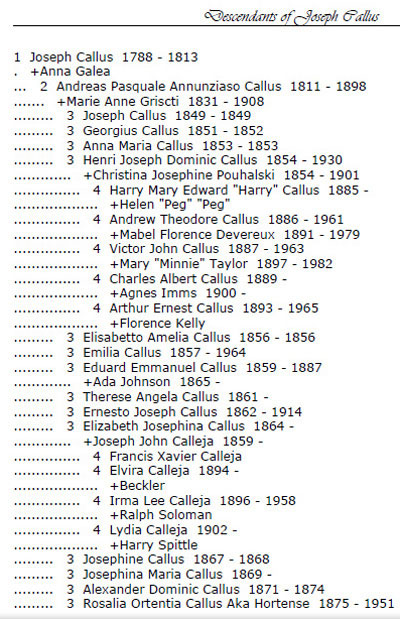 |
My Levantine heritage begins in Malta just after the Napoleonic Wars.
ANDREAS PASQUALE ANNUNZIASO CALLUS was born 27 May 1811 in Zebbug, Malta.
He was the only son of JOSEPH CALLUS and ANNA GALEA of Zebbug. Joseph was the owner of a spinning mill employing “a hundred hands” in the town of Zebbug, which was the hub of the island’s sail-making industry. There was a terrible plague
in 1813 which killed 4000 of Malta’s inhabitants including Joseph, who was only about 25 at the time while Andreas was still an infant. It is not known what happened to the mill after his death, but it is known
that there was an economic depression after the Wars so it can be speculated
that the family’s fortunes went into decline. In the 1820s and 30s however,
the Ottoman Empire began a programme of modernisation and started to attract
Western businessmen to the key ports of Smyrna and Constantinople. Around
1829, at the age of 18, Andreas left Malta for Constantinople and settled
in Galata [info], where he opened a ship chandlery [marine accessories]
business. He is believed to have also opened a chandlery in Smyrna. I would like to locate these businesses and would welcome any help or suggestions on where to look. In 1848, at the age of 38, Andreas married MARIE ANN GRISCTI at the R.C. church of S.S. Peter and Paul, Galata [info]. She was the daughter of JOSEPH GRISCTI DI MELITA (of Malta). According to family legend Marie Ann’s grandmother was BARONESS SCEBERRAS (or SCIBERRAS), a descendent of a very old, noble family from Malta. However I have been unable to locate any records to substantiate this link to the Sceberras family in Smyrna or Constantinople. Marie Ann was born at Smyrna in 1831 where her father settled after the death of her mother. Maybe her mother died in childbirth? When Marie was 12 years old (circa 1843) the family moved to Constantinople. She had 9 siblings, who may have been born in Smyrna or Malta. Her brothers EMMANUEL, ANTONIUS and SALVOTORE and her sister ANGELA married in Constantinople after 1843. Emmanuel later moved to Zongouldak, a mining town on the Black Sea Coast. Her other siblings, JOHN, CHARLES, GAUTHIER, PIERRE and THERESIA may have married in Smyrna prior to 1843. I have been unable to locate any catholic parish registers for Smyrna which would help me trace the Grisctis or Sceberras. Andrea and Marie were happily married for nearly 50 years until Andrea’s death in 1898. They had 14 children, 6 of whom died in infancy. In the 1890s they lived at Appt 4, Petraki Han, Bereket Zade, Galata, which is a street facing the Galata Tower. Marie died 25 May 1908. The surviving children of Andreas Callus and Marie Ann Griscti were: HENRI JOSEPH, b. 1854, EMILIA, b. 1857, EDUARD EMMANUEL, b. 1859, THERESE ANGELA, b. 1861, ERNESTO JOSEPH, b. Abt. 1862, ELIZABETH JOSEPHINA, b. 1864, JOSEPHINA MARIA, b. 1869, ROSALIA ORTENTIA CALLUS, b. 1875, (known all her life as ‘Hortense’). |
HENRI CALLUS was my great grandfather. His sisters EMILIA, THERESE and JOSEPHINE never married and it’s thought they worked as teachers in Constantinople. They emigrated to Malta probably sometime in the 1920s at the time of the main exodus of Europeans from Turkey. Hortense also remained single but stayed in Constantinople/Istanbul at least until the 1930s. In the 1920s she was residing at her late parent’s home near the Galata Tower, but by the 1930s had moved to Stamboul (the old quarter of Istanbul on the opposite side of the Galata Bridge on the European side of the city). She may have moved to the UK or Malta later in the 30s.
ELISE (ELIZABETH) CALLUS was the only sister to marry. She married JOSEPH JOHN CALLEJA in 1891 at the RC church of S.S. Peter and Paul in Galata. Joseph was born in Constantinople in 1859 to a banker called XAVIER CALLEJA and his wife MARIA PARIS (m. 1858). Joseph was also a banker. An advertisement for the Imperial Ottoman Bank in Constantinople dated 1914 shows a Calleja as the ‘chef’ for the Pera branch, but it is not known whether this was Joseph or maybe another member of his family. Elise and Joseph had 4 children, FRANCIS XAVIER, ELVIRA b. 1894, IRMA LEE b. 1896 and LYDIA, b. 1902. Lydia married HARRY SPITTLE in Constantinople in 1922. Irma married RALPH SOLOMON and Elvira married a Mr BECKLER, dates unknown. Both were British and moved their families to the UK. Francis Xavier worked for the British diplomatic service. He moved to Malta in the 1920s with his aunts Emilia, Therese and Josephine Callus. He later moved to London. |
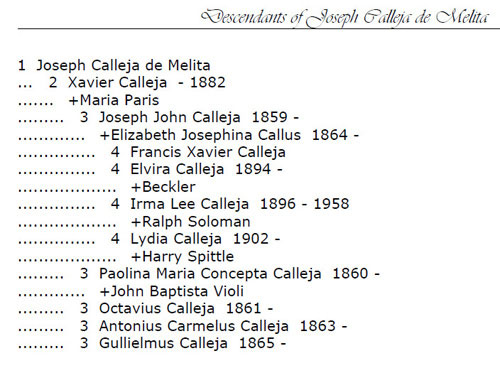 |
Notes: 1- Fellow contributor Alex Baltazzi was able to source this image, an advert from 1914, details of which were published in the book ‘135 Yıllık Bir Hazine - Osmanlı Bankası Arşivinde Tarihten İzler [A treasure trove of 135 years - Traces of History within the archives of the Ottoman Bank] - Edhem Eldem - an Osmanlı Bankası Publication, 1997’, the name of the manager of the Pera branch turns out to be M. A. Calleja, where M. must be short for Monsieur as all names have that in front - view details:
Ms. Fry’s comments:
This means the ‘chef’ at Pera would be A. Calleja. Clearly 1914 is too late for it to be Xavier who died 1882. However I notice that Joseph had a brother named Antonio/Antoine Calleja born 1863. I don’t know any more about him but it is possible that more than one son would have followed Xavier into banking in those days, so it just might be him, who knows? It would be great to find out whether any more info is held in the archives.
2- Mr Baltazzi was also able to find reference to Mr. A. Calleja in reference to Catholic rest home in Istanbul, the still functioning, ‘Artigiana’: “Bizans İmparatorluğu’nun günümüze Latin Cemaati ve Kilisesi [From the Byzantine Empire till today, the Latin Community and Church] - Rinaldo Marmara - Kitap Yayınevi Ltd, 2006, İstanbul”, on 12th October 1842, for the change of the constitution of Associazione Comerciale Artigiana di Pieta, a committee was selected consisting of 4 members (A. Crespin, C. Hippinger, G. Salzani, ve V. Bavastrelli) and 4 representatives (Baron T. Testa, Berzolese, G. Florio ve A. Calleja). The new constitution was approved on 10th of March 1844. (Ref: A. Palmieri: L’Associazione Commerciale Artigiana di Pieta in Constantinopoli).
Of Henri’s brothers, EDUARD EMMANUEL CALLUS trained as a marine engineer, possibly in Malta or the UK. In 1886, he was living in Gillingham in Kent and married Ada Johnson in Chatham. It is possible therefore that he trained at the Woolwich Arsenal, a centre of excellence for mechanical engineering in the 19th century. He died just over a year after his marriage in June 1887 at the County Asylum in Bridgend, Glamorgan age 28.
ERNESTO CALLUS did not marry and left Constantinople to live in Malta sometime around the 1880s. He was admitted to a mental hospital just outside Zebbug in Malta in 1890 suffering from mania. His medical records survive at the hospital and say that the British Consul in Constantinople arranged for his admission. He stayed there until his death from Tuberculosis in 1914, age 52, and is buried in a common grave.
My great grandfather, HENRI CALLUS, was Andrea and Marie’s fourth child and the first to survive. He was baptised at the RC church of S.S. Peter and Paul, Galata, Const. in 1854. According to family legend Henri served an articled engineering apprenticeship with Armstrong and Whitworth in Constantinople. In the 1880s this company had Henry working on warship installations at Woolwich near Chatham in a supervisory role and this led to the British Admiralty offering him a top job on their engineering staff which he turned down because he said he did not like the idea of working for the Government.
There are problems with this story however, as Armstrong and Whitworth was not formed as a joint company until 1897, although both existed as separate entities before then. This was a company known for fitting out machinery and weapons for warships. According to Ed Radstock, the Ottoman navy had ships built in the UK and fitted out with weaponry. It seems more likely therefore that Henri and his brother Eduard were sent to the UK around the 1860s to serve engineering apprenticeships around Woolwich, (where Whitworths had one of the first engineering technical colleges) paid for by their parents. We do know that Henry’s brother, Eduard, was definitely working near Woolwich in the mid 80s and on an old photo dated 1874, Henri writes his address as Greenwich, London.
After passing his exams we are told that Henri gained a sea-going ticket as second or third engineer in the Ottoman merchant navy and later gained his first, then chief engineer’s certificate. This was no mean feat in the 1880s as steam engineering came of age. It is believed that he was in the Black Sea trade working on tramp steamships sailing between Odessa, Constantinople, and Great Britain (probably Cardiff) for some years, with cargoes of coal from the UK and grain on the return trip.
Ed Radstock has provided some further information on the steamship trade of the period. The tramp steamers were simple ships of about 1000 – 4000 ton cargo capacity. They had no electricity, were very reliable and easy to maintain. The term “tramp” comes from the assignment arrangements, whereby the steamer’s route went wherever the owners sent it but the journey back was left for the captain to arrange a return cargo.
There is another family legend claiming that he was also on the crew that brought Cleopatra’s Needle to the Port of London in 1878. A number of different vessels were involved in this dangerous enterprise but it has yet to be confirmed whether Henry was definitely on one of them. This requires checking against the crew lists for the vessels involved, if that is, these lists survive. The fact that Henri was based around Greenwich in the 1870s, worked on steamships, was a qualified engineer and his first language was French, suggest this is not implausible. If Whitworth had any involvement in the removal of the needle in Egypt, Henri’s background would have been a real asset.
Henry married CHRISTINA JOSEPHINE POUHALSKI (aka PUCHALSKI) 22 September 1884 in S.S. Peter and Paul, Galata, Constantinople. Their marriage was registered in Cardiff, South Wales in 1885 when they decided to settle there.
|
|
|
Their 5 children were all born in Cardiff, the first, HARRY in 1885, ANDREW in 1886, VICTOR in 1887, CHARLES in 1889 and ARTHUR in 1893. Victor remembered being told that he was very nearly born at sea as Christina often accompanied Henry on his voyages even when she was expecting! Having a wife and family on board was unusual and suggests Henri had some sort of privilege, such as being a share owner of the ship. It would have been far from luxurious but did provide a means of staying in touch with far flung relatives! Moreover sailing was still a dangerous enterprise and there is a story that once they were all thrown overboard during a storm in the Bay of Biscay.
At some point Henry was involved in a serious accident at sea which left him crippled with rheumatism. In many late photographs he is seen with two sticks. His last job was on a yacht which he was unable to sustain because of his disabilities.
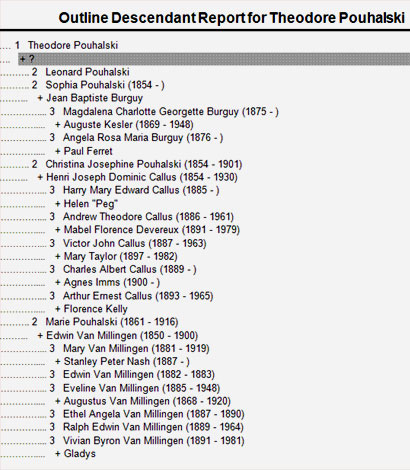 |
Henry’s wife CHRISTINA JOSEPHINE POUHALSKI was the daughter of a Polish cabinet maker called THEODORE POUHALSKI. She was born in 1854 and died 1901 in Cardiff, Wales. According to family legend Christina was born in Poland, but lived in Kiev, Ukraine, as a child. (According to Elena Tsvetkova of the Russian Baltic Information Centre BLITZ, the spelling of the surname POUHALSKI is a French version of PUCHALSKI, a surname fairly common in South Western Poland. . According to our family tradition, she was brought to Constantinople as a child with her two sisters, SOPHIE and MARIE, and a brother LEONARD or LEON. Several different stories have been passed down regarding their exile to Constantinople. The most common is that the parents fled to Turkey as part of the Great Emigration during the last Polish Revolt (1863-4), possibly travelling via Kiev and then Odessa. When they arrived in Constantinople the parents placed the children in a RC orphanage in Pera and then returned to Poland and never saw the children again. It has been further speculated that the family were given protection by the Baroness Sceberras, grandmother of Marie Ann Callus. This account was also recorded in a letter c.1965 recounting a conversation with Francis Xavier Calleja. Another story is that when the family arrived in Constantinople the parents were employed by the French Embassy as interpreters. Yet another version suggests that the family moved to Constantinople in order to seek treatment for one of the children, Marie, who had a serious eye condition, the city being renowned for its eminence in the treatment of eye disorders. |
Care has to be taken not to jump to conclusions and I recognise that children were sometimes placed in orphanages not only when parents died, but for reasons of safety or due to destitution. My attempts to try and trace any RC orphanages in the Pera district between 1860–80 have been frustrating and futile. All I can gather is that there may have been around 6 RC orphanages across the city. There was one at Bebek, but this is a few miles away up the Bosphorus. There was another at Darulaceze in the Şişli district but I am not sure of its denomination or whether this was too far away. It seems probable that the children were placed in a French-run institution as Marie was recorded as a French subject on her marriage certificate, the surname spelling is a French version and Christina’s first language was certainly French (although again one has to resist jumping to conclusions – French was the lingua franca of the Levant). The sisters appear to have had a good education which included lessons in etiquette and deportment. For instance there is evidence that each played a musical instrument, (Christina the violin, Sophie the harp), they spoke several languages as well as French and could read, write and draw. One family member recalls hearing stories that they went on hunting outings in the forests for wild boar. This tends to lend support to the theory that the children had a wealthy patroness or benefactor.
In 1872, Christina wrote her address in the fly-leaf of her bible giving it as ‘Maison Demilleville, No.303 Pera’. This has been traced to a luxury goods store selling women's clothing as well as jewellery and silverware, which opened 23 April 1867. The building is still standing at 303 Istiklal Caddesi in Istanbul and is home of the Rio Brava restaurant on the ground floor! The catholic church of St Antoine was also sited within the vicinity and was the main church for the expatriate Polish and Italian communities.
In the 1870s Maison Demilleville specialised in high fashion couture and accessories for the ball or theatre which could be tailor made within 24 hours. (Before we learned this, we had been told that Christina was a dress designer so the address appears to confirm this). When the store opened it was opposite the Russian Embassy Palace and in between a building called Concordia (no longer standing), and the Mısır Hanı (Egypt building) within which was a theatre called Trocodero. Stage shows were put on at the Trocodero and at other theatres nearby. (Source: Alex Baltazzi, contributor on this site). It seems unlikely that Christine would have been accommodated on the premises as the ground floor would probably have comprised the boutique with workshop and storerooms at the back, while the upper floors would have been expensive apartments, probably well beyond her means, so it is curious why she wrote it as her address.
Of Christina’s brother LEONARD, no information or records have been found. It is not even known for sure if he actually existed. One relative was told that he trained as a doctor and came to London but no evidence has yet been found.
According to family legend, Christina’s sister SOPHIE POUHALSKI married a French Count and lived a life of great luxury, eventually ending her days in the South of France near Nice. After much searching I have at last traced her marriage record to the French RC Church of St Mary Draperis in Pera. This shows that she married Jean Baptiste BURGUY in 1874, the son of Charles and Magdalena BURGUY. There is nothing to indicate his occupation or status but my grandfather VICTOR CALLUS did recall visits from Sophie and the requirement to use finger bowls at the dinner table when she stayed. He also remembered that she played the harp.
Sophie and Jean had two daughters; Magdalena Charlotte Georgette in 1875 (later known as Madeleine) and Angela Rosa Maria in 1876, who were baptised at St Mary Draperis. The family later moved to Paris, France. In 1899 in Paris, Madeleine married Auguste Kessler, a journalist from Rambervillers in the Vosges. Angela also married in Paris but not until 1920, when she would have been in her 40s. Her husband was Paul Ferret.
Much more is known about Christina’s younger sister MARIE POUHALSKI. She was born 1861 in Poland. One of her granddaughters, still living, remembers that Marie lived with her and her parents when she was very young. As such her recollections are somewhat eclectic. But she described her grandmother as a very beautiful woman with tiny feet, who was blind and kept a pet chicken which she took to bed with her!
In 1880, Marie was at a catholic orphanage in the Pera district of Constantinople (Istanbul), when she was visited by an English doctor specialising in eyes, called EDWIN VAN MILLINGEN, who came to treat her eye condition (documented in the autobiography of JULIUS ROBERTSON VAN MILLINGEN 1848-1940). Edwin was the son of JULIUS MICHAEL VAN MILLINGEN, MD, (compatriot of LORD BYRON at Missolonghi in 1823 and court physician to 5 successive Sultans of the Ottoman Empire) and his third wife ADELAIDE “Adele” LA FONTAINE (b.1819, daughter of JAMES LA FONTAINE and NICCOLETA COCCINI). The VAN MILLINGENS have their own long and illustrious history in the Levant, more of which I will mention later.
|
|
|
Edwin performed surgery on Marie so probably had to visit on several occasions. During this time, they began an affair and Marie became pregnant. However, Edwin was already married to an Austrian lady, JOHANNA FISCHER, who was childless and of fragile health! However, despite this, he continued his affair with Marie and probably provided for her and set her up with an address. The child, MARY, is believed to have been born in Graz, in Austria. This is near Vienna, where Edwin did his specialist medical training, so he may have sent Marie there for her confinement and to get her out of the way. That the affair was discovered shortly after the baby’s birth is suggested by a photograph of Edwin’s brother, which is addressed to Johanna and says “To Johanna, with the love and sympathy of Julius, 5 July 1881.” Johanna separated from Edwin and probably returned to Vienna.
Clearly the affair continued and in 1882, Marie had another child who was named EDWIN. He died a year later. In 1884, Marie became pregnant with EVELINE but on 10 December of that year, Edwin’s estranged wife died and the couple rushed to get married at the chapel of the British Consulate in Constantinople a mere 13 days later. There were no family witnesses recorded on the marriage register. Eveline was born a few weeks later in January 1885.
Marie had a further 3 children by Edwin. These were ETHEL, b.1887, who died at 3 years old of scarletina, RALPH EDWIN CHARLES VAN MILLINGEN b. 1889 and VIVIEN BYRON VAN MILLINGEN, b.1891.
In 1900, the family were living in San Stefano, now called Yeşilköy, a suburb of Istanbul. Edwin’s brother Julius wrote in his autobiography that on his last visit to Constantinople, Edwin did not see him off for his return voyage to England because he was suffering from flu. This was the last time that he saw him as a few weeks later he died, aged 50, at the British Seamen’s Hospital in Galata. Edwin is buried with his father in Haider Pasha cemetery, Scutari.
After Edwin’s death, it became clear that the family were in financial difficulties, because although Edwin had earned enormous sums of money, he was also a big spender. The children had been placed in Scottish boarding schools but the fees were in arrears. Julius and his half-brother ALEXANDER VAN MILLINGEN, and half-sister Countess EVELINA PISANI, felt obliged to pay off his debts and continue to pay for the education of the two boys, Ralph and Vivian. The girls, Mary and Eveline, went to live with their uncle Julius in Dunblane in Scotland.
In his Will Edwin left Marie only a shilling, which initially I read as a pointed snub to his wife. However, I have since been advised that this may instead have been an application of the inheritance rules in the “Code Napoleon” which was adopted by many countries formerly under French rule, such as Italy, Belgium, Portugal and Spain. This decrees that a man must leave his estate intact for his children to inherit in equal parts. The wife would normally have been left a token such as a shilling with the expectation that she would remain in the family home until her own demise. However as there was in reality only debts to inherit, Alexander interceded on Marie’s behalf and secured a pension for her from the Sultan for 500 piastres a month, 50 of which she was required to hand over to pay for the children’s ongoing education. It would be interesting to learn how much 500 piastres would have bought her in 1900. Was this a packet or a pittance?
In 1909, her daughter Eveline married her half cousin, a very wealthy entrepreneur, AUGUSTUS VAN MILLINGEN (b. 1868 Constantinople) in Bayswater, London. Augustus was the son of JAMES, half brother of Edwin. He was born in Constantinople and had numerous business interests including connections with the sultan. Eveline and Augustus moved to Alexandria in Egypt, where he owned the Windsor Hotel, the Summer Palace Hotel and a steam laundry, taking Marie to live with them. Augustus was killed in a motor car accident in 1920. Marie probably died about 1916 in Alexandria.
FURTHER NOTES ON VAN MILLINGEN
Dr Julius Michael Van Millingen’s first wife was the notorious MARIE DEJEAN, who was divorced by Julius for her outrageous behaviour. She had 3 children by Julius; JAMES, EVELINA and FREDERICK. She then married KIBRISLI MEHMED EMIN PASHA and changed her name to MELEK HANUM. Melek was finally convicted of being complicit in the murder of the chief eunuch in her hamman after he discovered that she had tried to pass off a baby she had bought in the back streets as her own when her own baby son was sickening. (She was afraid of losing her husband’s only heir). She was divorced by Kıbrıslı and exiled to Konya for 5 years. She escaped and wrote “Thirty Years in the Harem” (online version of the book - archive review) and “Six Years in the West”.
The second wife of Julius Van Millingen was ZAFIRA RALLI. She bore Julius 3 sons; ALEXANDER, CHARLES and a twin, JOHN, who died at birth. ALEXANDER VAN MILLINGEN was a prominent archaeologist and historian, who wrote extensively on Byzantine architecture and was Professor at Robert College [mentioned a few times in this account of the history of this college], later to become Boğaziçi University.
The third wife of Julius was ADELAIDE (ADELE) LA FONTAINE. She had 2 sons; JULIUS ROBERTSON VAN MILLINGEN b. 1848 and EDWIN b. 1850. Julius R had 4 children, including RUTH MARGUERITE who married SIR ANDREW RYAN, author of ‘The Last Dragoman’.
Note: In April 2012 I visited Istanbul and went to the SS Peter and Paul RC Church in Galata and while there spoke with Fr Lorenzo about trying to locate the orphanage of my Gt Grandmother. He suggested a building near the Italian Consulate and School off TomTom Kaptan could be the one. We wandered down there and turned right as indicated onto Boğazkesen and found the second or third building along had a faint plaque above the door with ‘St Joseph's Orphelinat’ - entry in the Annuaire Cervati almanac of 1895, showing it was for girls. I’ve since found some references online to a place called the ‘Secret Garden’ in Tophane on the same street which all mention a French run orphanage nearby. So who knows?
To follow Ms Fry’s wider quest for family lines, please check her blog:
To assist Ms Fry in her continuing quest to find out more of her various ancestral lines, please contact her on tesseric[at]tiscali.co.uk

